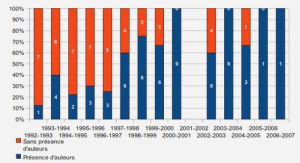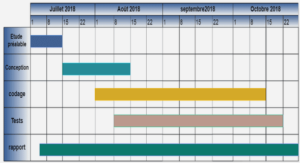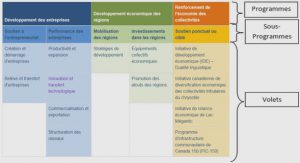Participation à l’activité physique de loisir chez les jeunes Canadiennes et Canadiens
Étude transversale multiniveau des différences de participation à l’activité physique de loisir chez les jeunes Canadiennes et Canadiens [Article révisé et re-soumis pour publication au CMAJ-Open en décembre 2015]
Résumé
Contexte : Le but de cette recherche est d’explorer les différences de participation à l’activité physique de loisir (APL) chez les jeunes Canadiennes et Canadiens associées aux caractéristiques contextuelles de leur milieu de vie.
Méthodes : L’étude se base sur les comportements d’APL de 54 832 jeunes âgés de 12 à 17 ans. Afin d’examiner l’influence de certaines caractéristiques contextuelles, une série de régressions logistiques multiniveaux est réalisée. Les observations sont structurées selon une hiérarchie géographique à quatre niveaux : individuel, le quartier, la région sociosanitaire et la province. La variable étudiée est un indicateur dichotomique d’équivalent énergétique représentant l’atteinte (ou non) des recommandations quotidiennes de participation à l’activité physique.
Résultats : Chez les deux sexes, les résultats montrent moins de chances d’atteindre l’équivalent énergétique recommandé pendant l’hiver. Le type de quartier montre un impact uniquement chez les filles, pour lesquelles les chances d’atteindre l’équivalent énergétique diminuent en milieu urbain. Chez les deux sexes, des différences sont observées entre les régions sociosanitaires et entre les quartiers à l’intérieur des provinces mais aucune différence n’est observée entre les provinces. Les indices de défavorisation sociale et matérielle vérifiés sont non significatifs.
Interprétation : Ces résultats suggèrent qu’une considération de la saisonnalité lors du développement de programmes et d’aménagement visant à promouvoir la participation à l’APL pourrait être avantageuse, particulièrement la considération des besoins inhérents à la saison froide. L’association des zones suburbaines et rurales avec des chances plus élevées d’atteindre le niveau recommandé de participation à l’APL chez les filles montrent que les installations disponibles en zones urbaines seraient mieux adaptées pour les garçons, rappelant ainsi les besoins en matière d’équité. Bien que la distribution des variations entre les provinces ne montre aucune différence globalement, l’analyse des résidus de niveau provincial révèle que certaines provinces se démarquent tout de même de la moyenne canadienne, justifiant un examen plus approfondi des stratégies de promotions de l’APL dans ces provinces.
Cross-sectional multilevel study of the differences in the level of leisure-time physical activity among Canadian youth
Charles Nadeau MSc, Laurence Letarte MATDR, Ramona Fratu MSc, E.O.D. Waygood PhD, Alexandre Lebel PhD
[Note: Les références contenues au Chapitre 2 de ce mémoire sont celles de l’article original et sont rapportées indépendamment à la fin du présent chapitre]
The available scientific evidence supports the overall conclusion that leisure-time physical activity (LPA) provides fundamental health benefits for young people (1). The documented benefits include increased physical fitness, reduced adiposity, favourable cardiovascular and metabolic disease risk profiles and reduced symptoms of depression (2-5). Among young people, the growth period is also shown as a critical time for the development of factors that have a great influence on health in adulthood, such as achieving an optimal bone health (6).
Understanding what influences youth to engage in LPA contributes to evidence-based planning of public health interventions, as effective programs will target factors known to contribute to physical inactivity (7). Research into correlates or determinants of LPA has burgeoned over the past two decades, but has mostly focused on individual-level factors (8). Among them, socioeconomic status indicators such as education (9) and biological factors such as body mass index (10) have been associated with differences in LPA participation. In the meantime, factors such as contextual area characteristics (e.g. built environment, socioeconomic deprivation) are less studied, but are thought to have widespread effects (8, 11).
A better understanding of all levels of influence on youth LPA can inform development of multifaceted interventions which are recognized to offer the best chance for success (12). Therefore, the aim of this study is to provide a clearer picture of the differences in the practice of LPA among young Canadians influenced by the contextual area characteristics. The objectives are: (a) to describe the geographic variations of LPA among young Canadians over time and (b) to explore how contextual area characteristics explain these variations.
The tested hypothesis is: contextual area characteristics influence the level of LPA among youth.
Methods
The use of multilevel analysis is recommended to consider and analyse the heterogeneity of grouped and non-independent observations (13). Estimating the impact of contextual area characteristics on LPA is thus performed by applying a binomial multilevel logistic model using a random intercept on four geographic levels: individuals, neighborhoods, health regions, and provinces.
Data source, study population and sample size
The study uses the Canadian Community Health Survey (CCHS) from 2003 to 2011. Repeated biennially this survey contains self-reported information from a representative sample of the population of at least 12 years old of age and living in the 10 Canadian provinces (14). The sub-sample used in the present analysis includes Canadians from 12 to 17 years old for whom data on ethnic origin, highest household education level, body mass index and geographic position are available. Pregnant girls, respondents interviewed by proxies and some observations lacking geographical concordance are excluded for consistency with the research design. Overall, this study relies on a sample of 54,832 observations.
Geographical structure
Observations are structured according to a four-level geographical hierarchy based on Statistics Canada 2006 census unit’s administrative structure. When a place of residence is located in an urban setting, i.e. included in a census metropolitan area or a census agglomeration, the “neighbourhood” corresponds to the census tract; otherwise it is attributed to the corresponding census subdivision or the municipality. The combination of census tract and corresponding census subdivisions enables the creation of comparable neighbourhood units that reflect the heterogeneity of the land use mix surrounding individuals’ place of residence whether they are located in an urban, a sub-urban or a rural setting. A detailed methodology of the geographical structure is presented by Lalonde (15). In order to take into account changes in the boundaries of the health regions during the study period, the geographic structure is harmonized using a digital boundary file reflecting the limits of the health regions in effect as of October 2011 (16). ArcMap 10.1 software is used for the geospatial processing. The final data hierarchical structure comprises 6004 neighbourhoods, within 112 health regions, and distributed through the 10 Canadian provinces.
Outcome
The dependant variable studied is a dichotomous indicator of LPA which refers to achieving (or not) the recommended daily level for physical activity. The guidelines recommend that young people aged 12-17 years should accumulate an average of at least 60 minutes of moderate to vigorous-intensity physical activity daily (17, 18). Physical activity level is estimated by an index of energy expenditure in which are considered the frequency, duration and intensity of 18 types of self-reported LPA (19). In order to overcome the absence of measure of intensity reported in the survey, the thresholds are derived from a table providing values of Metabolic Equivalent of Task (METs) attributed to the various activities (19). According to the theoretical works set out above, we consider that an “active” youth is one that achieves an index of energy expenditure of at least 30 kcal / kg / week (20) with a frequency of 5 times/week or more. To illustrate the achievement of this minimal value of ʺmoderate to vigorous-intensityʺ, the classical example is brisk walking (4.3 METs) done for 1 hour a day, 7 days a week (21).
Individual variables
To account for the consistently documented influence of various individual characteristics on LPA among youth (22-24), age, ethnic origin, highest education level of the household and body mass index are used as control variables. Table 1 presents the distribution of samples by all covariates.
Cycle and season
The survey produces a biennial microdata file combining data collected over a 12-month period (cycle 2003 and 2005) and a 24-month period (cycle 2007, 2009 and 2011). Knowing the exact date of sampling make it possible to discern differences in the odds of achieving the recommended level of LPA according to the season.Three seasons are created: Summer (July to October), Winter (February to March) and Transitional (November to January and April to June).
Area-based variables
Three independent area-based variables are considered. The first is the Census metropolitan influenced zone (MIZ). This variable focuses on the municipalities that are outside of the existing census metropolitan areas and census agglomerations and assess the degree to which these latter influence the municipalities, as measured by commuting flows. Three influence zones are created to represent the continuum in the variety of contextual area characteristics: urban (inside census metropolitan areas and census agglomerations), urban outskirts (Census metropolitan influenced zones 1-3) and rural (Census metropolitan influenced zones 4 and 5). A detailed methodology of the construction of the Census metropolitan influenced zone is presented by Statistics Canada (25). The two other area-based variables are based on the factor score of two dimensions issued from a principal component analysis and that estimates the material and social deprivation of the neighbourhood units where the individual’s residence is located. A detailed methodology of the deprivation indices used is presented by Pampalon (26). Deprivation is seen as a relative disadvantage facing the community to which an individual belongs. The distribution of neighbourhoods’ indices is broken into quintiles within each province.
Statistical analysis
To investigate the influence of the contextual variables, a series of multilevel logistic regression analyses is conducted using Bayesian estimation procedure as implemented via Markov chain Monte Carlo (MCMC) methods in MlwiN 2.28 software. This procedure is detailed in Browne and al. (27) and marked benefits of using Markov chain Monte Carlo procedure when analysing categorical outcome are detailed in Subramanian and al. (13). The modelling strategy is based on four incremental models which make it possible to interpret the impact of additional variables in the fixed part of the models on the random part of the models (between area variance). Additional information is provided in supplementary file (S1). The first model refers to the variance component and expresses the distribution of variance between the four geographic levels described above. The second introduces control variables, cycle and season. The third introduces the census metropolitan influenced zone. The last model introduces the neighbourhood’s social and material deprivation indices. The Deviance Information Criteria (DIC) is used to compare each model’s goodness of fit (28). The median odds ratio (OR) is used to translate the area level variance in the widely used OR scale, which has a consistent and intuitive interpretation (29). As the median OR can be directly compared to a regular OR, it is possible to evaluate the relative importance of the contextual area characteristics compared with other variables included in the model. All analyses are stratified by sex to control for the differences in physical maturation between girls and boys during the puberty (30).
Province level residuals analysis
We further use the province-level residuals and associated standard error (S.E.) to plot and rank the OR and the 95% confidence interval (CI) for each province. This procedure allows a visualization of provinces that have a significantly different chance of achieving recommended LPA level from the national mean.
Results
Table 1 presents summary statistics of the achievement of an energy equivalent of recommended level of physical activity among girls and boys. In the sample studied, 36.9% of the girls achieve the standard, and 51.9% of the boys. All models described in this section present the OR of achieving recommended LPA within 5% CI for each characteristic considered (fixed part). The between-area variance structure (random part) is analysed using the median OR. Variation in the median OR is considered significant when 1.96 times its S.E. remains lower than the between area variance.
|
Table des matières
Chapitre 1 – Introduction générale
Chapitre 2 – Étude transversale multiniveau des différences de participation à l’activité physique de loisir chez les jeunes Canadiennes et Canadiens
Chapitre 3 – Conclusion générale
Limites et critiques de l’étude
Annexe A
Annexe B
Annexe C
![]() Télécharger le rapport complet
Télécharger le rapport complet






